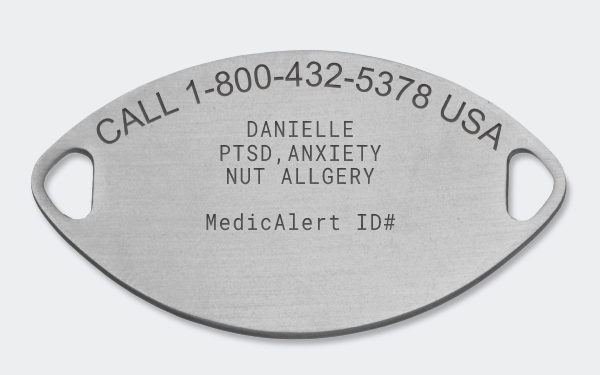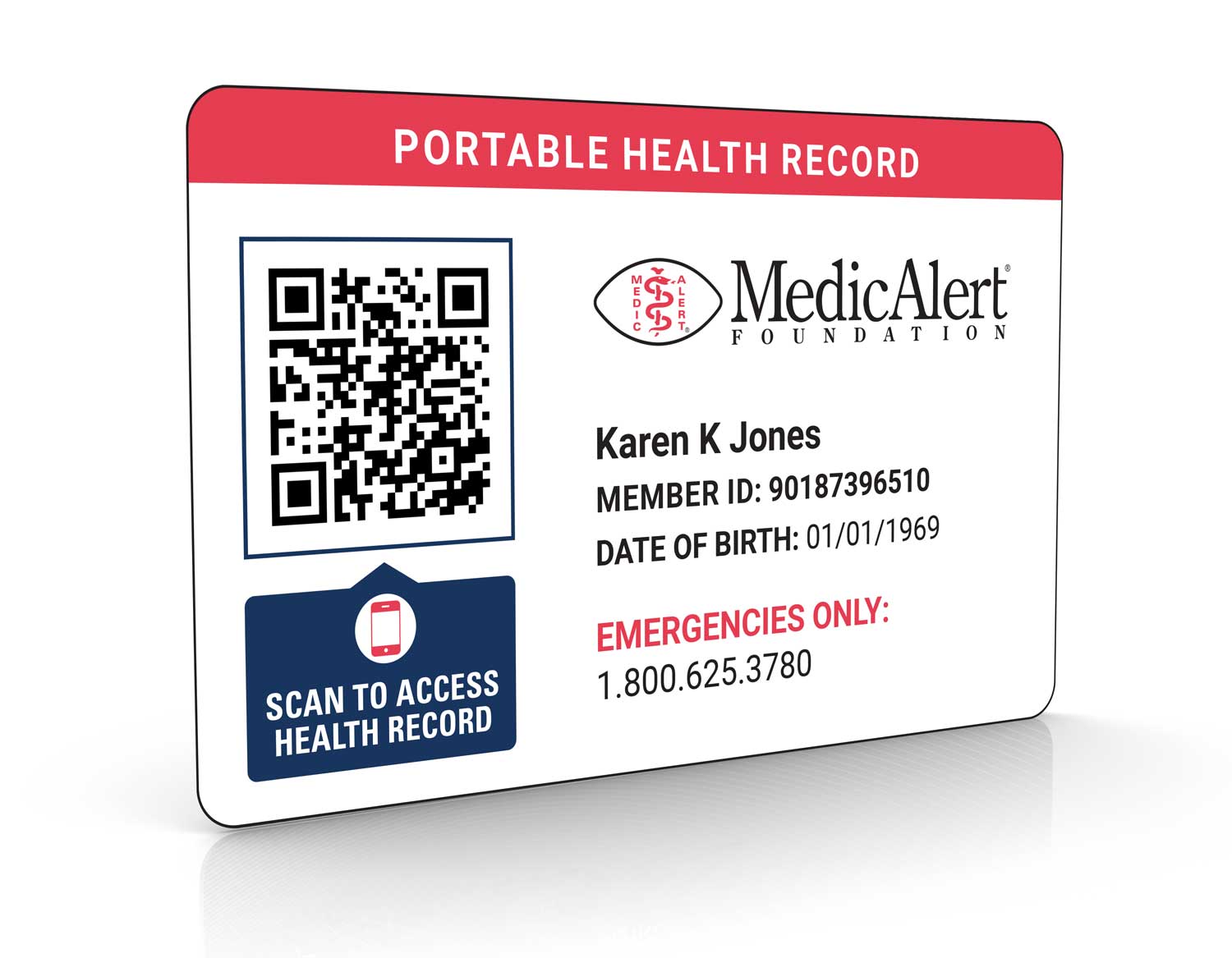Help others help you. Wear a medical alert ID bracelet or necklace engraved with important information for emergency responders and healthcare providers
Centers for Disease Control & Prevention

Medical IDs for PTSD
The confidence to live with post-traumatic stress disorder (PTSD)
Most people will experience some form of trauma in their lives. This can be the loss of a loved one, an accident, or even a broken heart. In the majority of these situations, the person will recover over time. However, some people don’t recover, which can lead to post-traumatic stress disorder (PTSD). In these cases, PTSD can be so severe, that it can interfere with day-to-day living. And because the disorder has similar symptoms to other conditions, it is not always recognized by healthcare professionals and others.
For this reason and many others, people living with the condition should wear a MedicAlert medical ID for PTSD.
How MedicAlert protects those living with post-traumatic stress disorder (PTSD)
One thing you shouldn’t worry about is what could happen if there’s an emergency. MedicAlert’s protection plans offer benefits that extend beyond the ID, providing safety and peace of mind for people living with PTSD, their families and caregivers.

24/7 Emergency Response
Our team provides first responders the information they need to provide fast, accurate care.

Digital Health Profile
All your vital information, all in one place for you and your caregiver.

Emergency Contact Notification
In an emergency, we connect families so that no one is alone in a crisis.

Patient Instructions
Share the information that’s important to your care, such as use of rescue medications or contraindication for tests like MRIs.
Pair a medical ID for PTSD with the protection plan that’s right for you.
What exactly is post-traumatic stress disorder?
Post-traumatic stress disorder is a psychiatric disorder that may occur after a person has experienced or witnessed a traumatic event. The event could be so terrifying that it will cause everything from intense nightmares to severe anxiety. While many people associate PTSD with military service, the disorder can affect anyone. In fact, the National Center for PTSD—a Division of the U.S. Department of Veterans Affairs—estimates that six out of every 100 people (or 6% of the population) will have PTSD at some point in their lives, and around 12 million U.S. adults have post-traumatic stress disorder in a given year.
About 8 of every 100 women (or 8%) develop PTSD sometime in their lives compared with about 4 of every 100 men (or 4%). PTSD can develop in children and teens as well. Studies show that about 15% to 43% of girls and 14% to 43% of boys go through at least one trauma. Of children and teens who have had a trauma, 3% to 15% of girls and 1% to 6% of boys develop PTSD.
What causes PTSD?
Post-traumatic stress disorder is triggered by a traumatic event. This can be any event that causes any type of physical, mental, or emotional pain. However, some of the most common traumatic events associated with post-traumatic stress disorder include:
- Being in an accident
- Being threatened with a weapon
- Childhood physical abuse
- Combat exposure
- Physical assault
- Sexual violence
Other traumatic events such as kidnapping, a robbery or mugging, receiving a life-threatening diagnosis, plane crash, fire or natural disaster, terrorist attack, or torture can lead to PTSD.
While doctors aren’t sure why some people develop post-traumatic stress disorder and others don’t, research suggests that certain risk factors can make it more likely that a person will develop PTSD after experiencing or witnessing a traumatic event.
Researchers at Mayo Clinic provide the following possible causes and risk factors for PTSD:
- Experiencing intense or long-lasting stress and trauma
- Having a job that increases the risk of being exposed to traumatic events, such as the military, first responders, and nursing (nearly 96% of nurses have experienced at least one symptom of PTSD and 21% meet the criteria for clinical diagnosis of PTSD)
- Having blood relatives with mental health problems, including anxiety or depression
- Having experienced other trauma earlier in life, such as childhood abuse
- Having other mental health problems, such as anxiety or depression
- Having problems with substance abuse, such as excessive drinking or drug use
- Inherited personality features (temperament)
- Lacking a good support system of family and friends
- The way the brain regulates chemicals and hormones that the body releases in response to stress
What to engrave on MedicAlert medical IDs for PTSD:
MedicAlert offers free custom engraving on all our PTSD bracelets and medical IDs for PTSD. Engravings on medical IDs for PTSD should include any critical medical information that can protect and save lives in an accident or medical emergency, for example:
- Post-traumatic stress disorder (PTSD)
- Current medications
- Designated physician contact information
- Emergency contact information
- Any other details vital to your care

Sample engraving. Consult our team if you need help engraving medical IDs for PTSD.
What are the symptoms and complications of post-traumatic stress disorder?
Symptoms of PTSD typically start within one month of a traumatic event, and they are the same for adults, teens, and children. However, children under six years of age may also re-enact the traumatic event or aspects of it during play. Symptoms of PTSD can vary in intensity, and they can appear when the individual experiences stress or are reminded of the traumatic event.
Symptoms of PTSD include:
Avoidance
- Not talking about the traumatic event
- Avoiding activities, people, and places that remind you of the event
Changes in emotional and physical reactions
- Angry outbursts or aggressive behavior
- Being easily frightened or startled
- Having your guard up in anticipation of danger
- Irritability
- Issues with focusing and concentrating
- Overwhelming feelings of guilt or shame
- Self-destructive or reckless behavior, such as alcohol and drug abuse or driving too fast
- Sleep problems
Negative changes in mood and thinking
- A feeling of detachment from family and friends
- Disinterest in activities you once enjoyed
- Feeling hopeless about the future
- Inability or difficulty experiencing positive emotions
- Inability to or difficulty maintaining close relationships
- Memory problems, including not remembering important aspects of the traumatic event
- Negative thoughts about yourself, people, and/or the world
- Not feeling or expressing emotions (emotional numbness)
Intrusive thoughts
- Distressing dreams or nightmares
- Flashbacks of the traumatic event
- Repeated, involuntary memories
Post-traumatic stress disorder can disrupt your job, health, relationships, social life, and day-to-day activities. People living with PTSD also have an increased risk of other mental health problems such as:
- Anxiety
- Depression
- Eating disorders such as anorexia and bulimia
- Drug and alcohol abuse
- Suicidal thoughts and actions
How do you diagnose PTSD?
Post-traumatic stress disorder can occur with other related conditions, such as memory problems, substance abuse, depression, and other physical and mental health problems. A trained therapist will look for these issues by using one or more screening instruments, and they will also determine how long you have been experiencing symptoms. The following criteria must be met to receive a diagnosis of PTSD:
- Have at least two symptoms of emotional and physical reactions
- Have at least one symptom of intrusive thoughts (recurring memories of the traumatic event, reliving the event, nightmares)
- Have three or more avoidance symptoms
- Have two or more negative changes in mood and thinking
- Symptoms must cause significant distress or problems with daily functioning
- Symptoms must last for more than a month
PSTD screening instruments include:
- Primary Care PTSD Screen for DSM-5 (PC-PTSD-5), five-item screen designed to identify individuals with probable PTSD in primary care settings
- Short Post-Traumatic Stress Disorder Rating Interview (SPRINT), eight-item self-report measure that assesses the core symptoms of PTSD
- SPAN (Startle, Physically upset by reminders, Anger, and Numbness), a four-item self-report screen derived from the Davidson Trauma Scale
- Trauma Screening Questionnaire (TSQ), 10-item symptom screen that was designed for use with survivors of all types of traumatic stress
In addition to screening instruments, your therapist or doctor may perform a physical exam.
How do you treat, manage, and live with post-traumatic stress disorder?
While treatment for post-traumatic stress disorder will vary by individual, the gold standard of treatment is a combination of psychotherapy and medication. Examples of psychotherapy for PTSD include:
- Cognitive therapy, talk therapy aimed at correcting distorted thinking.
- Exposure therapy, aimed at helping the individual face their fears for long enough to get used to them.
- Eye movement desensitization and reprocessing (EMDR), combines exposure therapy with a series of guided eye movements to help the person process traumatic memories and change their reaction to them.
Selective serotonin reuptake inhibitors (SSRIs) and serotonin-norepinephrine reuptake inhibitors (SNRIs) are recommended for PTSD. The following four are the most effective:
- Effexor (venlafaxine)
- Paxil (paroxetine)
- Prozac (fluoxetine)
- Zoloft (sertraline)
With the help of therapy, medications, and the support of family and friends, PTSD can be managed.
How medical IDs for PTSD combined with MedicAlert Membership provide peace of mind
For those living with PTSD, medical IDs for PTSD plus a MedicAlert protection plan can play an important role in helping you manage the condition. A MedicAlert ID and protection plan can keep you safe by alerting emergency responders and ER doctors of your condition if you are in a medical emergency or crisis that requires hospitalization. A MedicAlert ID and protection plan can connect emergency responders and your ER team with designated doctors and specialists. The combination of medical IDs for PTSD and a protection plan can even help streamline the check-in process for patients’ regular doctor and specialist visits.
- We’re your voice: If you can’t speak for yourself due to a medical emergency, your ID will speak for you – informing others about your PTSD and any medications you’re taking.
- 24/7 emergency protection: In an emergency, the MedicAlert team will relay all of your critical medical information to first responders, no matter where or when your emergency happens.
- Always connected: You should never be alone in an emergency. That’s why MedicAlert will reach out to your designated contacts if you are unable to do so.
- Live with peace of mind and confidence: MedicAlert will be there for you every step of the way. You’ll have the confidence and freedom to live your life with PTSD, knowing we’ve got you covered.
DISCLAIMER: THIS WEBSITE DOES NOT PROVIDE MEDICAL ADVICE. The information in this article is presented for educational purposes only and is not intended as a substitute for professional medical advice, diagnosis and treatment. Always seek the advice of a physician or other qualified healthcare provider for any questions you may have regarding a medical condition or treatment.







